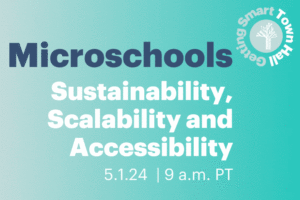60+ Education Gifts to Add to Your List

Still finishing up your holiday shopping? Tired of your youngsters or family members being excited about gifts for a few weeks then getting bored of them? Well, we’re here to help! This year, give the gift of knowledge with toys and gadgets that support learning and are sure to excite youth all year long.
Webster defines technology as “the use of science in industry, engineering, etc., to invent useful things or to solve problems.” This means that experiences that ignite a love of STEM are not limited to computers, tablets, and smartphones, but instead can be focused on creating, inventing and making.
This list is designed to be more than just your typical list of bots and batteries–this is a set of gifts for kids of all ages that help in the development of skills such as observation, creativity, problem-solving, critical thinking, collaboration, and persistence.
Ages 0 – 3
Budding Builders. The basic idea here is building sets for toddlers, which means they are designed for little hands and require limited coordination. A couple of options to check out:
- Guidecraft Grippies™ Better Builders 30 Piece Building Toy: These are large enough for little hands and encourage tactile exploration and magnetic play, providing a fun first experience with geometry and engineering.
- Imaginarium Jumbo Foam Building Blocks: Even though they are designed to build with, these foam blocks are a great opportunity to practice picking up and dropping into baskets or identifying colors and shapes.
- Imaginarium Big Bricks Building Set: The beauty of these big blocks is that they are easy for small hands to stack—they don’t require the same level of precision that smaller blocks do.
- Educational Insights Design & Drill Activity Center: Power tool sets are great, and a blast for this age, but can sometimes be hard if they don’t actually get to build anything. This is a great option for kids to use tools to design and create.
Cute Little Counters. At this age, most “counting” is more memorization than a deep understanding of quantity, but kids are never too young to play with numbers, even if they are really just increasing awareness:
- Munchkins Letter & Numbers: You have to do bath time, why not throw some letters in there? Not only does foam stick to the bathtub, but it also floats. As kids get older, playing with letters and numbers can increase to identifying colors & building order. Extra bonus: While in the tub, throw some measuring cups in there so that they can play with volume and measurement.
- Geometric Animal Shape Puzzles: Speaking of bath time. How about helping your little one learn geometric shapes while in the tub?
- Learning Resources Jumbo Magnetic Numbers: Just like the foam building blocks, putting numbers on the refrigerator (and then taking them back off) is great for building fine motor skills.
Abstract Artists. You may not be able to tell what it is that they have created, but giving toddlers the space to make is important and fun. The key in picking your “first” art supplies is all about what they will be able to control and hang on to:
- My First Crayola Crayons: The shape of these crayons make them perfect for little hands to hold and they don’t take much pressure to work which makes them just the right first crayon for your little one. Here’s a star-shaped option as well.
- ALEX Jr Finger Paint Party: The great thing about finger paint is that there is nothing for little hands to hold on to. Keys to remember: they WILL want to eat it the first couple of times so don’t forget to check for washable and non-toxic. You can also find bubble bath options for bath time.
Can’t Forget the Classics. These “oldies but goodies” are the toys we all remember and still love. These were the things we were playing with before STEM was a “thing:”
- Melissa and Doug Abacus: The O.G. of the calculator world.
Ages 3 – 5
Creative Construction. This age is where you may actually start to recognize the things your toddler is creating. From tools to blocks to art supplies, they will love transforming their ideas into reality–make sure they are set up with all the supplies they need to do so (and don’t forget to head to the recycle bin for lots of free inspiration):
- Picasso Tiles: Take building to the next level by starting to construct 3D shapes through these magnetic tiles.
- Educational Insights Design and Drill Activity Center: Power tool sets are great, and a blast for this age, but can sometimes be hard if they don’t actually get to build anything. This is a great option for kids to use tools to design and create.
- Learning Resources: Gears! Gears! Gears!: Take a different spin on building with these colorful gears that promote reasoning and problem solving while putting together moving objects and shapes.
Optimistic Observers. For young explorers, the world is full of surprises. These toys are designed to help them take their observation skills to the next level:
- Educational Insights EI-5112 GeoSafari Jr. My First Microscope and Educational Insights GeoSafari Jr. My First Telescope: These first microscopes and telescopes allow kids to take a closer look at all of their favorite things.
- Learning Resources Primary Science Mix And Measure Set: This is a great age to start to build a better understanding of quantity and measurement. The mix and measure set can double as a great bathtime toy as well.
- Backyard Safari Magnifying Glass: The perfect stocking stuffer.
Robots for Rugrats. Stu Pickles shouldn’t be the only inventor in your house. Even though robotics toys tend to be aimed at middle and high school, there are lots of great resources for the young robotic enthusiast that can help support building an innovation mindset:
- Fisher Price Think and Learn Code-a-pillar: A great first start to coding. Depending on how you put this guy together, it changes his course. Set a target and then build him to hit it.
- Kids First Robot Engineer Kit and Storybook: They call it a “build along adventure.” Start by reading the story and build as you go. This Robot Engineer teaches kids about simple machines and gear trains
- WowWee COJI The Coding Robot: This guy teaches the basics of coding through the language of emojis.
- LEGO Coding Express: Inspire early learners to start exploring coding concepts such as looping, conditional coding and sequencing, while also developing their problem-solving skills, critical thinking and social and emotional skills. Check out our recent review.
Terrific Tablets. Sick of sticky finger smudges on your tablet? Here are a couple of options just for them (both under $100):
- Amazon Fire Kids Edition: While this is currently out of stock, it’s worth adding to your list for future gift ideas! The Kids Edition includes a free year of FreeTime Unlimited (a library of 10,000 vetted and kid-appropriate apps, ebooks and show) plus a protective case, a comprehensive 2-year warranty against accidents, and best-in-class parental controls.
- LeapFrog Epic: Parent controls that allow you to manage what, when and how long each of your children are playing for (up to 3 profiles) and also includes the LeapFrog Just for Me Learning technology that personalizes the experience for each kid.
Can’t Forget the Classics. These oldies, but goodies are the toys we all remember and still love. These were the things we were playing with before STEM was a “thing:”
- Learning Resources Pretend & Play Calculator Cash Register: Have you met a youngster who doesn’t love a cash register? This toy unlocks great opportunity for imaginative play and also encourages beginning math skills.
Ages 6 – 8
Mini Makers. A quick search online will yield more maker kits than you can count. They vary in complexity and cost, but no matter what your budget there is definitely something for your mini maker:
- Marbleocity Mini Coaster: Fat Brain Toys is a great starting spot for unique, maker type sets for kids of all ages. This is a great option for beginners as they follow illustrated instructions to piece together wooden parts to build the ultimate roller-coaster marble run experience.
- littleBits STEAM Student Set: A toolbox containing LEGO-like electronic building blocks that connect via magnets to build basic functional technology. For more check out our review.
- Makey Makey: A simple invention kit designed for beginners, experts and everyone in-between.
- ZOOB BuilderZ S.T.E.M. Challenge: This kit gives all the tools needed for kids to design and build creations to solve challenges provided such as hitting targets, making a ball bounce and more. Encourages and helps learners apply important STEM principles.
- Osmo Genius Kit: This is great for families looking to change up their iPad routine. Osmo Genius kit transforms your device into a hands-on learning tool fostering skills in math, spelling and visual thinking.
Creepy Crawlers. You may not love bugs, but chances are your kids do. If that is the case, here are a couple options that let your kids explore and observe, but keep the bugs well contained:
- BugWatch Boxed Set: This set includes a Double Viewer cone and scope, three collecting jars with magnifying lids and two pairs of tweezers. Great for collecting and viewing insects and other small creatures.
- Celestron 3D Bug Specimen Kit: These are real bugs encased in crystal clear resin for easy viewing. You can choose from 3 different kits, each containing a different set of insects.
Dare to Design. No matter what the age, there is a series of tools that help young people design, build and create. Find one that’s perfect and unique so that they love the experience:
- Roominate: Building kits designed specifically for creative girls.
- Fat Brain Toys Squigz- Starter Set Building Kit: Suction construction set.
- Chalktrail: This allows kids to turn their bikes into art tools.
Captivating Coding. Our kids will need to learn to code, but it is for more reasons than you might think. As Grant Hosford puts it, “Computer science is the perfect gateway to 21st-century skills. The logical problem solving and algorithmic thinking at the core of computer science force kids to think about thinking–a process referred to as meta-cognition that has proven benefits related to self-monitoring and independent learning:”
- CodeSpark: This app teaches the ABC’s of computer science while igniting curiosity and allowing kids to learn at their own pace. The curriculum follows the Common Core Standards for Mathematics and the Computer Science Teachers Association’s Computer Science Standards.
- Move the Turtle: This app teaches the general idea of coding by completing step by step tasks that move the turtle around on the screen. Successful completion means that newer and more complicated tasks are introduced (think next-gen frogger).
- Daisy the Dinosaur: This is a free app that uses a drag and drop interface to make Daisy the dinosaur come to life while teaching the basics of objects, sequencing, loops and events.
- PloBot: Get in early by supporting this Kickstarter campaign. PloBot is a robot companion that teaches programming logic through storytelling and play–with cards instead of screens.
- Brilliant: Master key ideas in math, science, and computer science through problem-solving.
Can’t Forget the Classics. These oldies, but goodies are the toys we all remember and still love. These were the things we were playing with before STEM was a “thing:”
- Stomp Rocket: An old favorite of many of ours, except this one glows in the dark!
Ages 9 – 11
Root Robot. So who is Root and what can Root do? Described as “a little robot with a lot of possibilities,” Root is “an educational robot that teaches coding, creativity, and problem-solving skills to kids from pre-readers through high school.”
Lets Start Coding. You’ll want to be sure to check out the Code Rocket and Code Piano. You may remember our review of the coding a car and a fishing tackle base kit. Fast forward to today and the latest products to spark our interest from electronic coding kit maker Let’s Start Coding are the newly launched Code Rocket and Code Piano.
Ask About AI. There is no doubt about it that Artificial Intelligence will have a major impact on the lives and livelihood of our kids. Here are a couple of examples of how AI is already working its way into our kids’ toyboxes:
- The Wild Robot: This wonderful book, recently reviewed by our own Carri Schneider, tells the story of “Roz”–a robot who washed up onto the beach to find remote island wilderness after the cargo ship transporting her, and dozens like her, sank.
- Anki Overdrive: This is the next generation of racing cars. Not only can you use a smartphone to control it, but you can choose whether you want to race against friends or AI controlled cars.
- Genibo SD Robotic Dog Artificial Intelligence Pet Robot: This smart robot puppy can even recognize its owner with its eyes, although I am not sure that that makes it quite worth its hefty price tag.
Maker Mindsets. We are big believers that allowing students to create, construct and value their unique passions is a great way to get them to think critically about the world around them. Makers make the world a better place and these gifts encourage the mindsets needed to do just that:
- Monthly Maker Kit Subscriptions: Make tinkering and creating a regular family event with a subscription from Creation Crate or Tinker Crate. Each month you will be mailed everything you need for the perfect at homemaker experience.
- KNEX Intro to Structures: Bridges: KNEX has a ton of great sets, but this one is particularly cool as you are set up to build 13 fully-functioning replicas of real-life bridges. Builders learn about infrastructure by demonstrating key bridge types, such as truss, arch, cantilever, beam, suspension, movable/bascule, and cable-stayed.
- Klutz LEGO Chain Reactions Craft Kit: Get your kids to build moving machines that solve real problems. This kit comes with 80 pages of instructions, 33 LEGO pieces, instructions for 10 modules, 6 plastic balls, string, paper ramps, and other components.
Smart Scientists. Science class can be really fun, especially when you actually get your hands dirty. These gifts bring the science lab home and allow you to dive into and explore deeply scientific principles:
- SmartLab Ultimate Secret Formula Lab: This formula lab comes with 40 experiments that teach kids about scientific principles such as air pressure, fluid dynamics, acids, and bases by exploring chemical reactions with different substances from around the house.
- Edible Chemistry Kit: Enough said.
Can’t Forget the Classics. These oldies, but goodies are the toys we all remember and still love. These were the things we were playing with before STEM was a “thing.”
- Thames and Kosmos Crystal Growing: Grow dozens of crystals, explore cause and effect, and help your family learn about the structure and geometry of crystals while building critical thinking and problem-solving skills.
- Erector Set: A classic lives on! Build, rebuild and create endless structures with this kit aged from 8-88 which means fun for the entire family.
10 Gifts that Cultivate SEL
- Inside Out (Movie | all ages). This year, Pixar melted our hearts once more with a film that gets you right in the feels by teaching kids and adults to recognize and honor their emotions. Here are 12 ideas on how to use the movie Inside Out to Teach SEL and get through life’s ups and downs. For an added bonus stock up on the book set as well.
- “What to Do When __________. “ (Book | upper elementary through middle school). Magination Press has published a series of “What to Do Guides” (e.g. What to Do When You Worry Too Much, What to Do When Your Temper Flares) that come in a graphic-friendly workbook. The books include strategies for kids (and adults!) to apply when they feel angry, worried, stuck and/or downright grumpy.
- Happify. (App | middle school and up). This app walks kids and parents through activities that are “de-stressors.” Thanks to Happify, games such as “Negative Knockout” provide fun ways to practice gratitude, learning breathing techniques and enjoy a sense of calm. Happify is targeted primarily towards adults, so this is best for older kids.
- Worry Woos. (Books + stuffed animals | birth – elementary ) The WorryWoos book series and accompanying stuffed animals make emotions real for kids in such a way that make them excited about expressing their feelings.
- Cooperative Games. (Games | all ages): Rather than focusing on the competition, cooperative games, like Forbidden Island (ages 10 – 12) and Race to the Treasure (ages 5 – 8) are great ways to build collaboration and teamwork as they require teams to work together to problem solve. They encourage and teach valuing a variety of perspectives and utilizing individual contributions to achieve success as a team.
- Lego Today I Feel Emotion Chart (Printable | elementary): This free printable from And Next Comes L allows kids to practice identifying how they are feeling, which in turn will support personal well-being and relationship building.
- Worry Eaters. (Stuffed animal | preschool – elementary): The zippered mouths of these worry eaters are designed to gobble up kids’ concerns all well teach kids how to better communicate and develop effective coping methods. Kids write or draw their worries and concerns and place them in the worry eaters mouth (a zipper pocket) — imagine these as the next generation of worry dolls.
- Daniel Tiger’s Grr-ific Feelings. (App | Preschool): This free app from PBS Kids lets kids explore feelings through games, drawing, songs and even a photo booth that helps them connect facial expressions to the way they are feeling.
- American Girl WellieWishers. (Toys | upper elementary): The WellieWishers are a group of dolls who, just like the traditional American Girls, each have a storyline of their own (and enough accessories to keep plenty busy). However, they are a little different in that the focus of these girls is a dedication and commitment to being good friends.
- Children’s Books. (Books | all ages): There is no shortage of children’s books that focus on feelings and the qualities of becoming a good friend or a confident individual. Books like Spaghetti In A Hot Dog Bun, My Many Colored Days, Stick and Stone, What if Everybody Did That and Rude Cakes are great ways to ignite powerful conversations with kids. The adults might learn some helpful tips as well.
What’s your favorite educational gift? Share in the comments section below!
For more at-home resources check out:
- The Getting Smart Podcast | Cultivating Young Mathematicians
- 5 Math Activities To Do With Your Kids
- The Maker Movement, What it Looks Like, Mindsets & Motivation
Stay in-the-know with innovations in learning by signing up for the weekly Smart Update.





Tyra
Best list I have ever seen. Will be sure to share with my friends. Thanks!
Lucy
Excellent list, will definitely help with my shopping. Thanks!
rachel frampton
This Christmas, I'm thinking of giving my nieces and nephews educational toys, such as Christian fantasy kids books because this will help hone their learning. Well, aside from the books, you are also right that it will be a great idea to give them star-shaped crayons. I'll also keep in mind to look for Picasso tiles since this will help them construct 3D shapes.